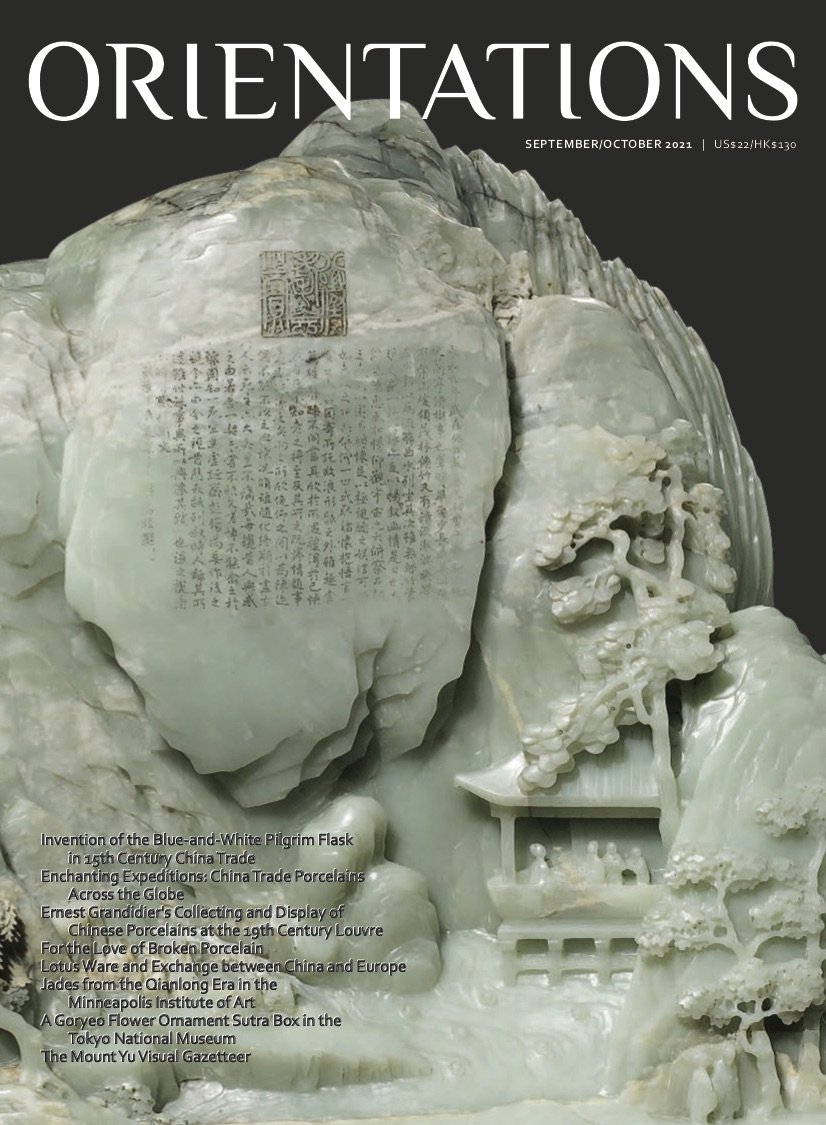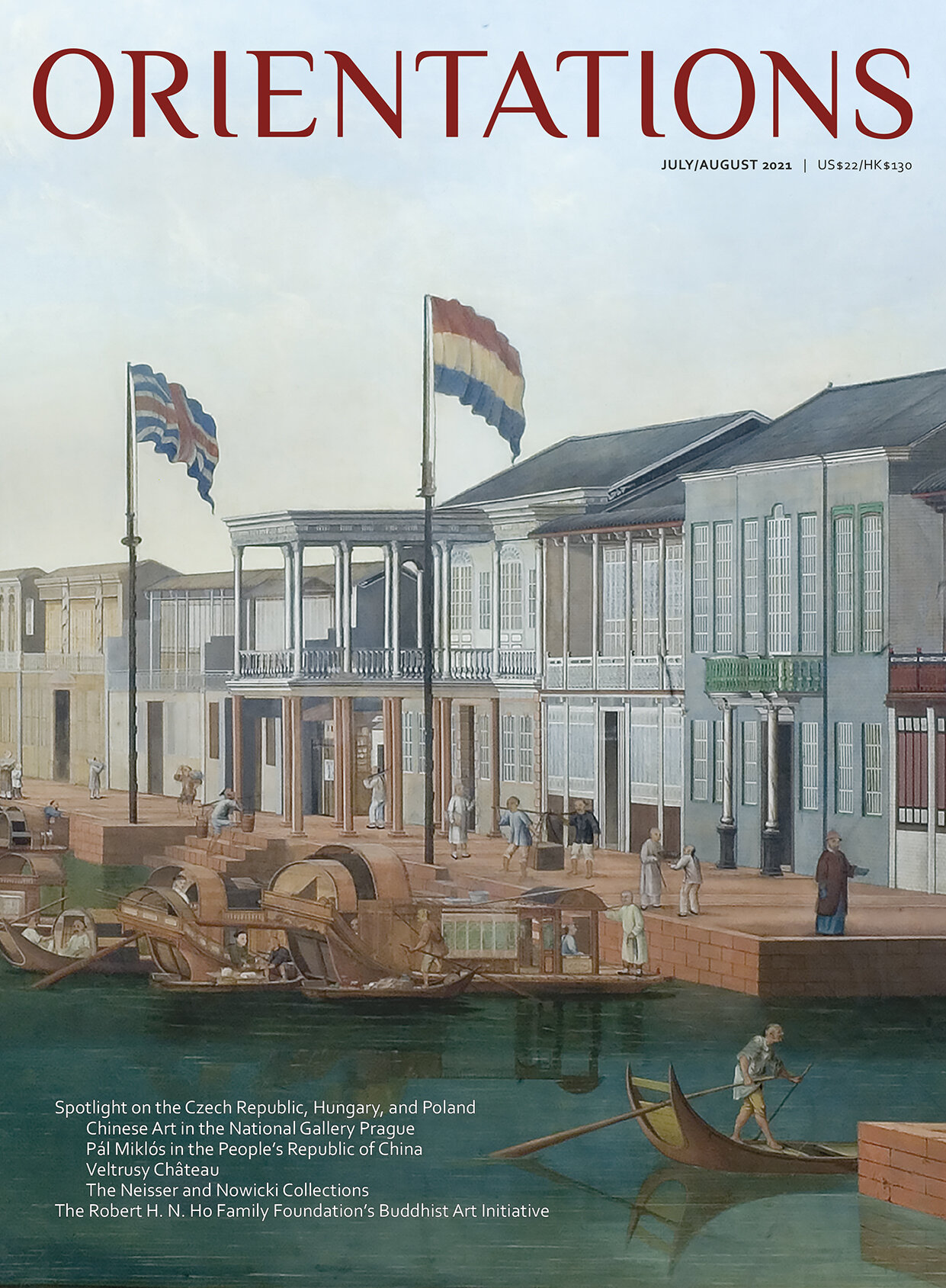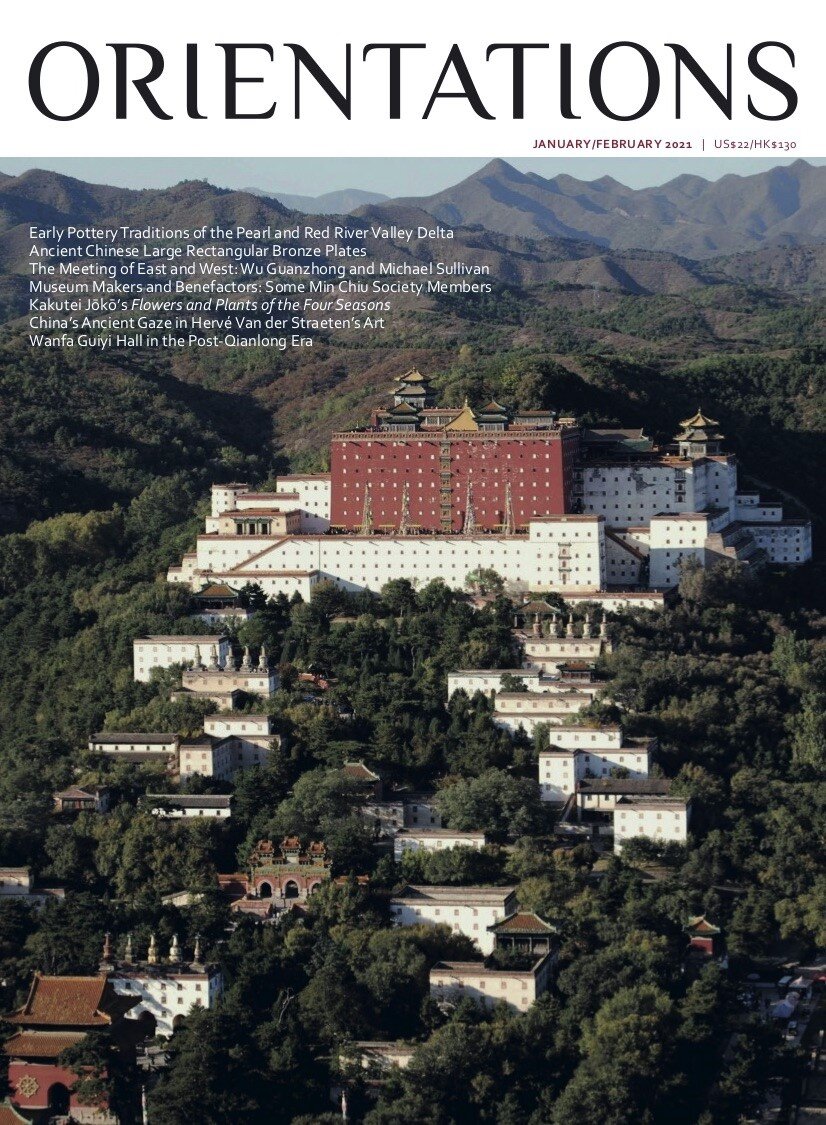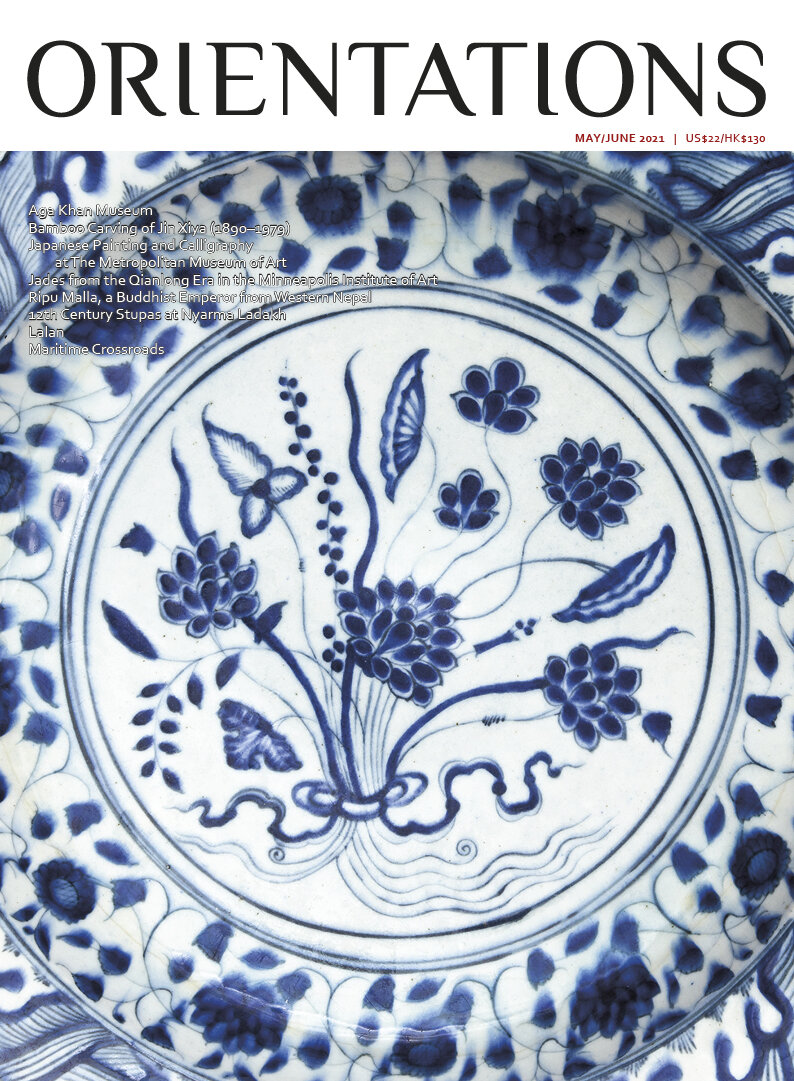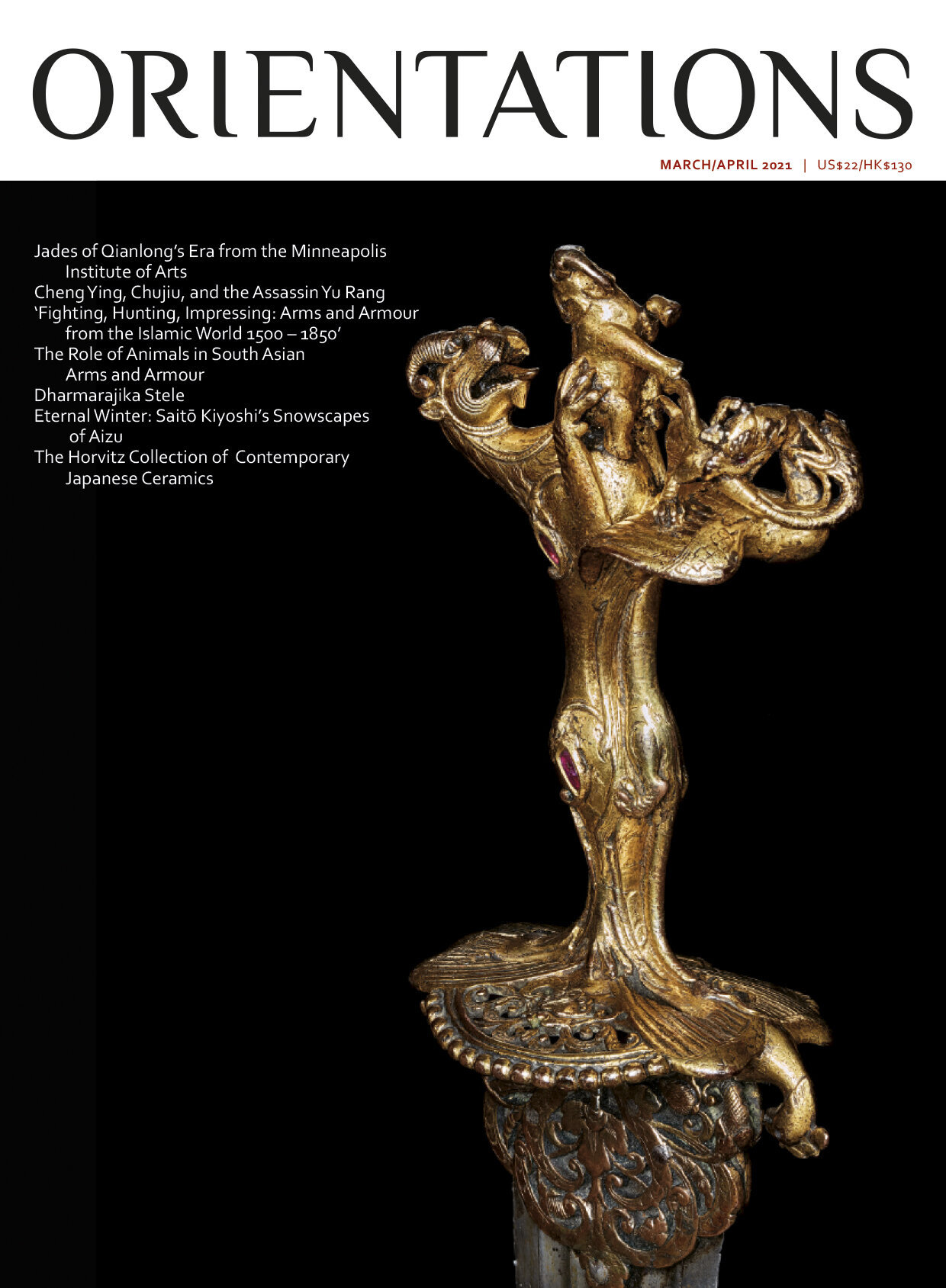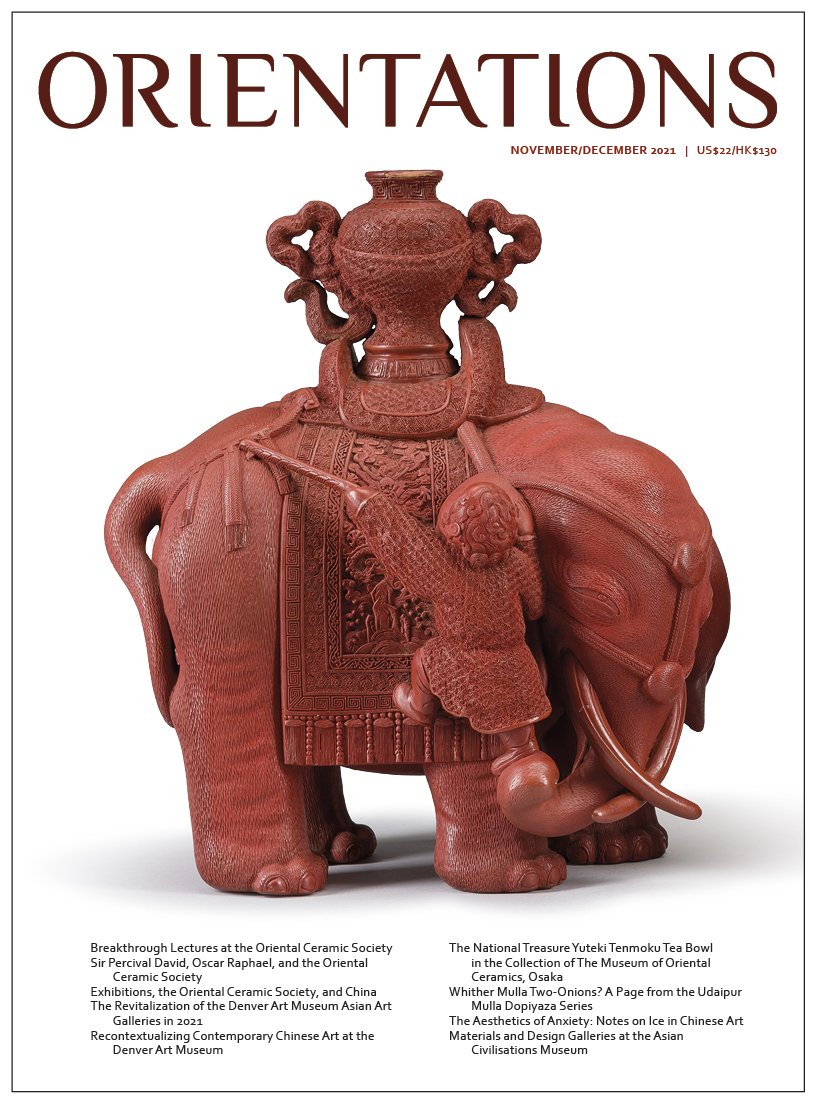SEP/OCT 2021
VOLUME 52 - NUMBER 5
This issue celebrates one of China’s most renowned inventions—ceramics—and relays storiesfrom its domestic development to worldwide trade. During the periods of the Yongle (r. 1403– 24) andXuande (r. 1426–35) emperors, much of the blue-andwhite porcelain produced during this era was inspired by Islamic objects of glass, metal, or ceramics. At first glance, the popular pilgrim-flask shape seems to be also modelled on a West Asian prototype, butmit cannot be traced to one. This shape was a Chinese invention motivated by diplomatic exchanges inthe 14th century between China and West Asia, as they were often given to tributary envoys to the Ming dynasty court as a symbol of hospitality and prosperity of the empire.
Chinese ceramics became one of the most prized commodities during the Ming dynasty as European traders brought them back to their home countries. To illustrate this history, ‘Enchanting Expeditions: Chinese Trade Porcelains Across the Globe’ at the Art Museum of the Chinese University of Hong Kong will display more than 200 pieces (sets) of trade porcelain wares from the Art Museum and other collections this fall. We look at the beginnings of this maritime trade and the characteristics of the early trade pieces.
The export of Chinese ceramics thus sparked many collections in the West, such as that of Ernest Grandidier (1833–1912), who installed his collection of over 6,000 porcelain items at the Louvre Museum in 1894. We move from this early 20th century collection to the contemporary collection of Cynthia Lee Johnson, a patron of the Philadelphia Museum of Art. We survey a range of lotus ware, and propothat this is a distinct genre of Chinese and European ceramics which marked the beginning of a ‘global culture’.
Although less well known compared to the prominent collections of Yuan dynasty (1272–1368) porcelain in the Topkapi Sarayi in Istanbul and National Museum of Iran in Teheran (formerly at the Ardebil Shrine), the Archaeological Survey of India’s collection in Delhi is roughly twice as large. We follow the stories of three individuals and the lure of this Delhi hoard.
We return with the final part of ‘In Pursuit of the Picturesque: Jades of Qianlong’s Era from the Minneapolis Institute of Arts’, in which we explore the themes, iconography, literary associations, and materials of jade mountains commissioned by Qianlong (r. 1735–96). Lastly, we are pleased to announce the launch of a new website where one will find the latest updates, art news and events, and select article highlights.
FEATURES
Xuan Chen. The Invention of the Blue-and-White Pilgrim Flask in 15th Century
China Trade
Wang Guanyu. Enchanting Expeditions Chinese Trade Porcelains Across the Globe
Yuet Heng Wong. ‘Decolonizing’ Chinese Porcelains Ernest Grandidier’s Collecting and Display
at the 19th Century Louvre
Steven P. Gaskin, Dr Aprajita Sharma, and Dr Ellen S. Smart. For the Love of Broken Porcelain
The Efforts to See, Study, and Share the World’s Largest Collection of Yuan-dynasty Blue-and-white Porcelain
Cynthia Lee Johnson and Harrison Schley. The Fragrant Blossom: Lotus Ware and Exchange between China and Europe
Liu Yang. In Pursuit of the Picturesque Jades from the Qianlong Era in the Minneapolis Institute of Art (Part 3)
Nanhee Lee. A Goryeo Flower Ornament Sutra Box in the Tokyo National Museum: A Technical Study
Feier Ying. The Mount Yu Visual Gazetteer A Curated Album of Regional Networking in Late 17th Century China
REVIEWS
Roslyn L. Hammers. Nordic Private Collections of Chinese Objects by Minna Torma
VOLUME 52 - NUMBER 5
This issue celebrates one of China’s most renowned inventions—ceramics—and relays storiesfrom its domestic development to worldwide trade. During the periods of the Yongle (r. 1403– 24) andXuande (r. 1426–35) emperors, much of the blue-andwhite porcelain produced during this era was inspired by Islamic objects of glass, metal, or ceramics. At first glance, the popular pilgrim-flask shape seems to be also modelled on a West Asian prototype, butmit cannot be traced to one. This shape was a Chinese invention motivated by diplomatic exchanges inthe 14th century between China and West Asia, as they were often given to tributary envoys to the Ming dynasty court as a symbol of hospitality and prosperity of the empire.
Chinese ceramics became one of the most prized commodities during the Ming dynasty as European traders brought them back to their home countries. To illustrate this history, ‘Enchanting Expeditions: Chinese Trade Porcelains Across the Globe’ at the Art Museum of the Chinese University of Hong Kong will display more than 200 pieces (sets) of trade porcelain wares from the Art Museum and other collections this fall. We look at the beginnings of this maritime trade and the characteristics of the early trade pieces.
The export of Chinese ceramics thus sparked many collections in the West, such as that of Ernest Grandidier (1833–1912), who installed his collection of over 6,000 porcelain items at the Louvre Museum in 1894. We move from this early 20th century collection to the contemporary collection of Cynthia Lee Johnson, a patron of the Philadelphia Museum of Art. We survey a range of lotus ware, and propothat this is a distinct genre of Chinese and European ceramics which marked the beginning of a ‘global culture’.
Although less well known compared to the prominent collections of Yuan dynasty (1272–1368) porcelain in the Topkapi Sarayi in Istanbul and National Museum of Iran in Teheran (formerly at the Ardebil Shrine), the Archaeological Survey of India’s collection in Delhi is roughly twice as large. We follow the stories of three individuals and the lure of this Delhi hoard.
We return with the final part of ‘In Pursuit of the Picturesque: Jades of Qianlong’s Era from the Minneapolis Institute of Arts’, in which we explore the themes, iconography, literary associations, and materials of jade mountains commissioned by Qianlong (r. 1735–96). Lastly, we are pleased to announce the launch of a new website where one will find the latest updates, art news and events, and select article highlights.
FEATURES
Xuan Chen. The Invention of the Blue-and-White Pilgrim Flask in 15th Century
China Trade
Wang Guanyu. Enchanting Expeditions Chinese Trade Porcelains Across the Globe
Yuet Heng Wong. ‘Decolonizing’ Chinese Porcelains Ernest Grandidier’s Collecting and Display
at the 19th Century Louvre
Steven P. Gaskin, Dr Aprajita Sharma, and Dr Ellen S. Smart. For the Love of Broken Porcelain
The Efforts to See, Study, and Share the World’s Largest Collection of Yuan-dynasty Blue-and-white Porcelain
Cynthia Lee Johnson and Harrison Schley. The Fragrant Blossom: Lotus Ware and Exchange between China and Europe
Liu Yang. In Pursuit of the Picturesque Jades from the Qianlong Era in the Minneapolis Institute of Art (Part 3)
Nanhee Lee. A Goryeo Flower Ornament Sutra Box in the Tokyo National Museum: A Technical Study
Feier Ying. The Mount Yu Visual Gazetteer A Curated Album of Regional Networking in Late 17th Century China
REVIEWS
Roslyn L. Hammers. Nordic Private Collections of Chinese Objects by Minna Torma
VOLUME 52 - NUMBER 5
This issue celebrates one of China’s most renowned inventions—ceramics—and relays storiesfrom its domestic development to worldwide trade. During the periods of the Yongle (r. 1403– 24) andXuande (r. 1426–35) emperors, much of the blue-andwhite porcelain produced during this era was inspired by Islamic objects of glass, metal, or ceramics. At first glance, the popular pilgrim-flask shape seems to be also modelled on a West Asian prototype, butmit cannot be traced to one. This shape was a Chinese invention motivated by diplomatic exchanges inthe 14th century between China and West Asia, as they were often given to tributary envoys to the Ming dynasty court as a symbol of hospitality and prosperity of the empire.
Chinese ceramics became one of the most prized commodities during the Ming dynasty as European traders brought them back to their home countries. To illustrate this history, ‘Enchanting Expeditions: Chinese Trade Porcelains Across the Globe’ at the Art Museum of the Chinese University of Hong Kong will display more than 200 pieces (sets) of trade porcelain wares from the Art Museum and other collections this fall. We look at the beginnings of this maritime trade and the characteristics of the early trade pieces.
The export of Chinese ceramics thus sparked many collections in the West, such as that of Ernest Grandidier (1833–1912), who installed his collection of over 6,000 porcelain items at the Louvre Museum in 1894. We move from this early 20th century collection to the contemporary collection of Cynthia Lee Johnson, a patron of the Philadelphia Museum of Art. We survey a range of lotus ware, and propothat this is a distinct genre of Chinese and European ceramics which marked the beginning of a ‘global culture’.
Although less well known compared to the prominent collections of Yuan dynasty (1272–1368) porcelain in the Topkapi Sarayi in Istanbul and National Museum of Iran in Teheran (formerly at the Ardebil Shrine), the Archaeological Survey of India’s collection in Delhi is roughly twice as large. We follow the stories of three individuals and the lure of this Delhi hoard.
We return with the final part of ‘In Pursuit of the Picturesque: Jades of Qianlong’s Era from the Minneapolis Institute of Arts’, in which we explore the themes, iconography, literary associations, and materials of jade mountains commissioned by Qianlong (r. 1735–96). Lastly, we are pleased to announce the launch of a new website where one will find the latest updates, art news and events, and select article highlights.
FEATURES
Xuan Chen. The Invention of the Blue-and-White Pilgrim Flask in 15th Century
China Trade
Wang Guanyu. Enchanting Expeditions Chinese Trade Porcelains Across the Globe
Yuet Heng Wong. ‘Decolonizing’ Chinese Porcelains Ernest Grandidier’s Collecting and Display
at the 19th Century Louvre
Steven P. Gaskin, Dr Aprajita Sharma, and Dr Ellen S. Smart. For the Love of Broken Porcelain
The Efforts to See, Study, and Share the World’s Largest Collection of Yuan-dynasty Blue-and-white Porcelain
Cynthia Lee Johnson and Harrison Schley. The Fragrant Blossom: Lotus Ware and Exchange between China and Europe
Liu Yang. In Pursuit of the Picturesque Jades from the Qianlong Era in the Minneapolis Institute of Art (Part 3)
Nanhee Lee. A Goryeo Flower Ornament Sutra Box in the Tokyo National Museum: A Technical Study
Feier Ying. The Mount Yu Visual Gazetteer A Curated Album of Regional Networking in Late 17th Century China
REVIEWS
Roslyn L. Hammers. Nordic Private Collections of Chinese Objects by Minna Torma

